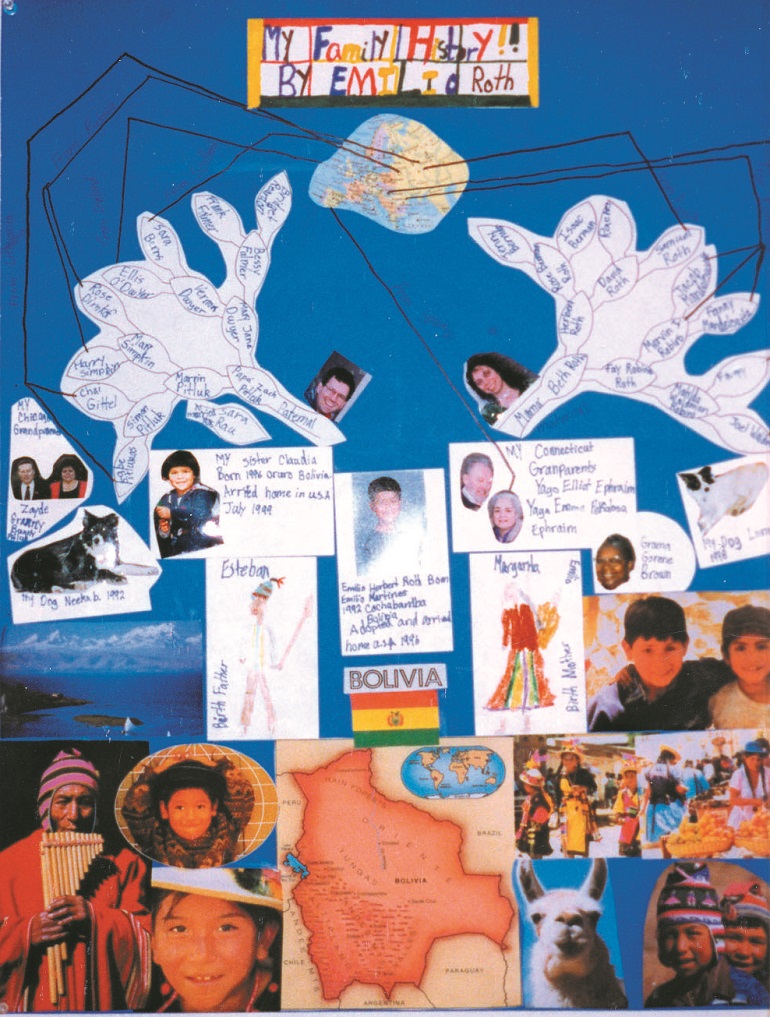When my son, Emilio, was in the third grade, his class began a theme study of “Families.” After a variety of activities, the project culminated with a family tree project for kids in her class. His teacher’s sensitivity and flexibility were impressive. She asked that “family history” and “family tree” be interpreted loosely, that each child’s finished project reflect his unique family. A family tree could be done in the traditional, tree-branch-and-leaf way, or as individual leaves with family member’s names arranged in a different shape. It could be in any format the child chose; the people included could be any important people in the child’s life.
After much family discussion about how to best represent Emilio’s adoption, birth history, and family, Emilio embraced the project with enthusiasm and creativity. He made the decision to create a collage in which the lower portion represented his roots in his birth country, Bolivia. We copied photos from his favorite books about Bolivia. Along the bottom, he placed a large map of Bolivia, flanked by pictures of Bolivians dressed in native clothing, and a photo of a llama. Above the map, he placed the Bolivian flag, and the title “Bolivia.” Pictures of the Andes and of Bolivian children lined the edges. The center featured Emilio’s photo with the caption: “Emilio Herbert Roth. Born Emilio Martinez, 1992, Cochabamba, Bolivia. Adopted and arrived home in the USA, 1996.”
We have very little information about his birth parents other than his birth mother’s name. I reminded Emilio that it was up to him whether to include them at all. He insisted that he wanted to include both his birth parents, and became quiet and reflective as he contemplated how to represent them. His face lit up, and he said, “I know-I’ll draw pictures of my birth parents!” He drew a beautiful woman with black braids and labeled her “Margarita, Birth Mother.” Then, he added a black-haired baby, wrapped in a colorful cloth and strapped to the mother’s back, and wrote “Emilio.” Pleased, he began to draw a picture of a man wearing a Bolivian hat and labeled him “Birth Father.” He decided that he wanted a name for his birth father, so he came up with a unique idea—he would simply choose one! After leafing through his books about Bolivia, he chose “Esteban.”
Emilio also included photos of his sister, dogs, grandparents, and close family friends. There were two tree branches, one representing me, my parents and antecedents, and the other representing my husband’s lineage. Above these two branches, he put a map of Europe, drawing lines connecting his relatives to their origins in various countries. He titled the collage “My Family History!!” The finished product was beautiful, colorful, and almost as tall as Emilio!
When he showed the collage to his teacher, he pointed out the drawings of his birth parents, saying, “I don’t have photos of my birth parents, so I drew pictures of them. And I don’t know my birth father’s name, so I chose the name ‘Esteban’!” His teacher praised him for his creativity. The collage remained part of a class exhibit for several weeks. Since bringing it home, over two years ago, he has kept it prominently displayed on his bedroom wall. He still enjoys it, and it continues to be admired by friends and family.



